Hefezopf recipe for sweet German bread
Oh Hefezopf, my favourite sweet German bread! This is the stuff I grew up on! There was not a single family celebration, Easter morning or gathering of any sort that would go without this baked delight.
Hefezopf is one of those foods us Southerners get given the moment we’re allowed to eat. Just like pretzels, this sweet German bread never disappoints. If you haven’t had one before, make your way into the kitchen right now. You won’t regret me introducing you to Hefezopf, I promise you.
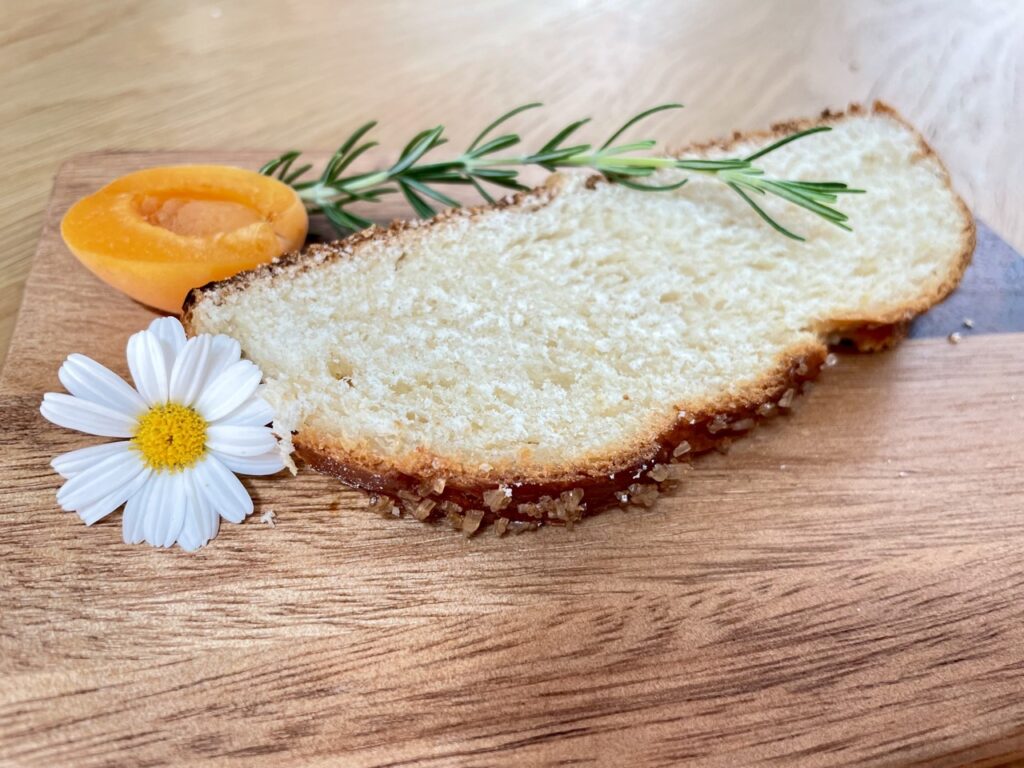
The tradition of Hefezopf
In the heart of Southern Germany, where the snow covered peaks of Alpine mountains can just about be made out in the distance, lies a culinary delight that embodies delicate deliciousness: Hefezopf. This beautifully braided bread with its golden crust and soft, fluffy interior, has become a staple in Southern German culture. From family gatherings to cozy breakfasts, this sweet German bread brings an essential component of everyday life and festivities alike.
There’s something so satisfying about the process of creating Hefezopf. Watching the dough come together, seeing it rise and rise, then shaped into a beautiful braid only to rise some more. With only a handful of ingredients – flour, milk, eggs, butter, yeast and sugar – one can embark on a culinary journey that delights, warms and satisfies. Working up an appetite while baking it, you are reminded that Hefezopf is the ideal food to embrace tradition, community and the joy of simple pleasure.
What sets Hefezopf apart is its super easy preparation, making it appealing to novice up to the most experienced bakers. Just like the citizens of Southern Germany themself, Hefezopf requires no fancy equipment or specialised techniques to turn out perfect. While most are driven away from attempting to create delicate pastries and desserts, you will be surprised to see how quick and easy this Hefezopf recipe is. We could call it time-tested methods, passed down by generations. Or we could just acknowledge that Hefezopf dough is fuss free and only wants to be left alone for a few hours to do its thing.
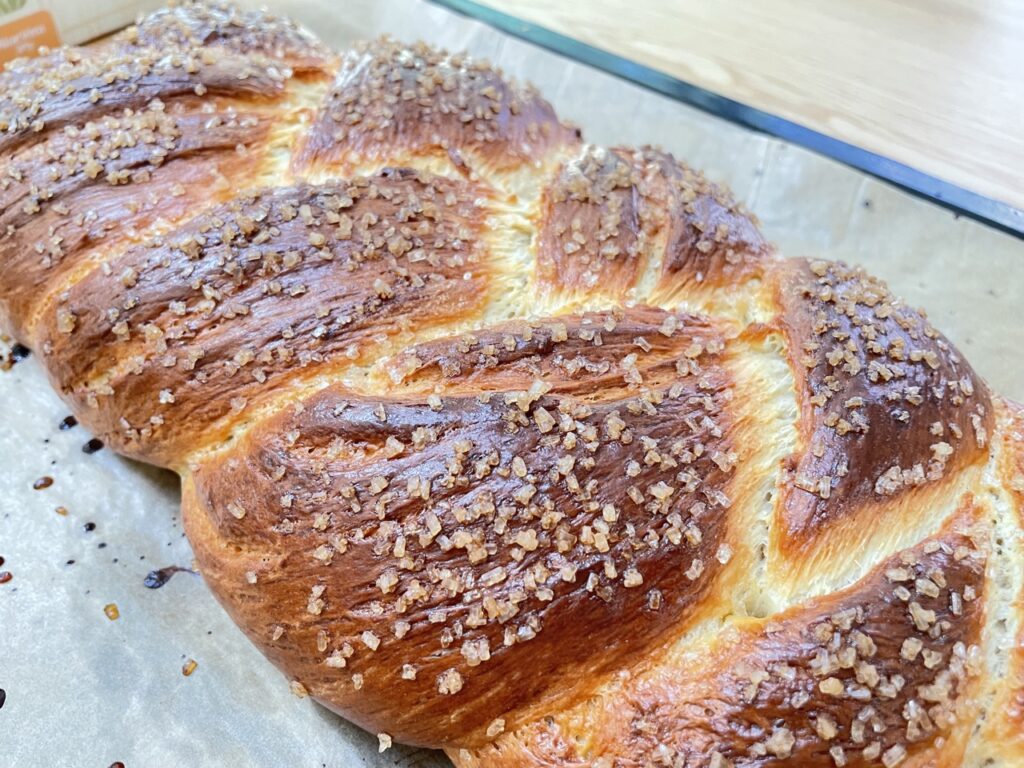
Growing up
For myself, baking Hefezopf is more than just a culinary endeavour – it’s a way of life. From kneading the dough to watching it rise, every step of the process is a memory of Germany, my mother, grandmother and heritage. Every step is a little bit of anticipation turning into excitement as the fluffy dough turns golden.
While I myself have so many great memories involving Hefezopf, the true magic of this sweet German bread lies on its versatility. Whether enjoyed fresh out of the over with a generous amount of jam, butter or my personal favourite, Nutella, or served alongside more savoury breakfast foods, Hefezopf adapts effortlessly to any occasion. I can’t think of an occasion where Hefezopf is frowned upon. It’s the perfect companion for a leisurely breakfast, coffee break or high tea. The delicate, fluffy pastry with its subtle sweetness providing the perfect counterbalance to the richness of everyday life.
Talking about the subtle sweetness, there is something so addictive in the flavour of a Hefezopf that will have you coming back even after you are full. Call me crazy, but there’s something magical about sinking your teeth into a slice of this freshly baked sweet German bread. The slight sweetness of the dough, the buttery richness of the crust, the airy texture that practically melts in your mouth – it’s an explosion on your senses. Each bite is a symphony of flavours and textures, a celebration of the simple joys that make life worth living.
That’s why in the South of Germany, Hefezopf is more than just a bread. It’s a symbol of tradition, community and the timelessness of great food. With that, let’s get baking.
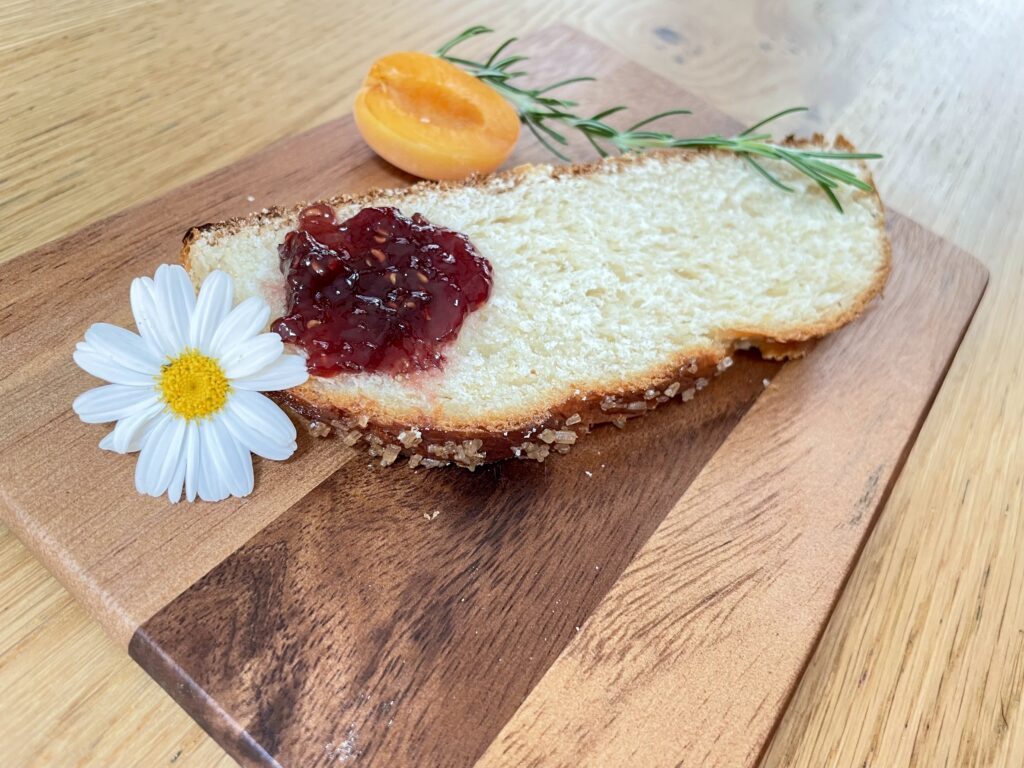
Tools you may need
- Baking sheet
- Parchment paper
- Stand mixer
- Large mixing bowl
- Silicone brush
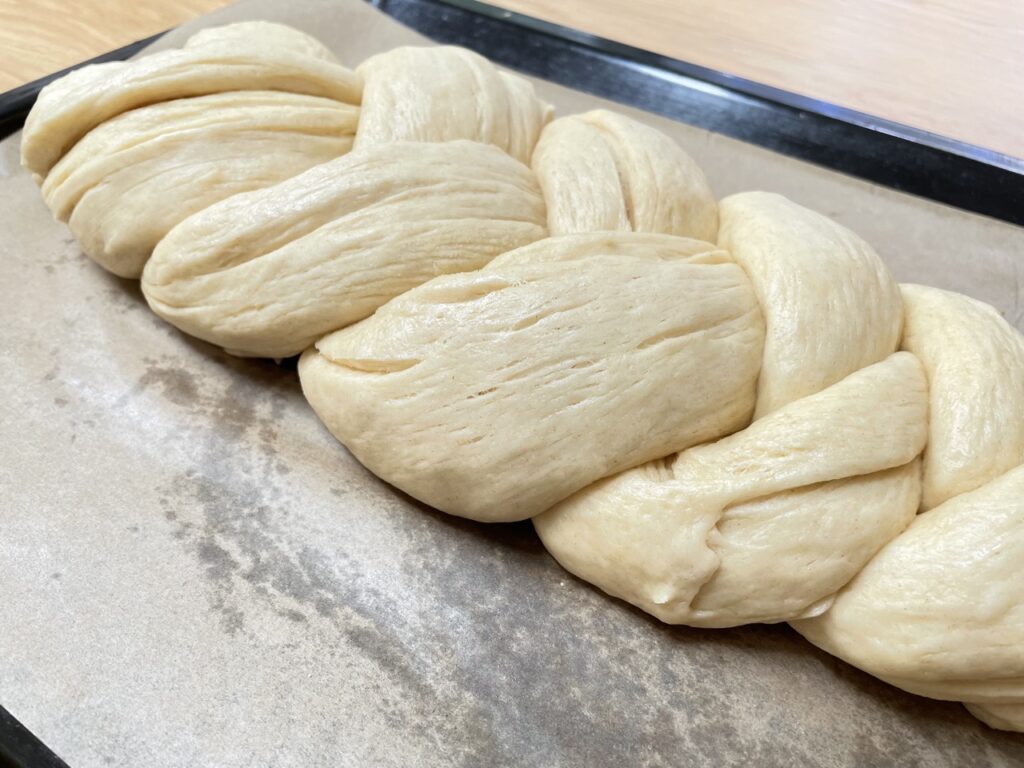
Ingredients
Milk
Butter
Flour
Yeast – We usually use fresh yeast, but it’s so difficult to find in other parts of the world. This recipe was therefore adjusted to use dry yeast.
Sugar
Vanilla essence – you can substitute this for vanilla sugar or fresh vanilla bean
Salt
Eggs
Sugar crystals – We use white ones in Germany but again, they’re not as readily available elsewhere. To substitute, try and use any larger crystals of sugar you have access to
How to make Hefezopf
First, let’s warm up the milk and melt our butter in it. Pour your milk into a small sauce pan and add your butter to it. Place the pot on low to medium heat to allow the butter to melt. Given we want to add this mixture to our dough, this should not turn hot. If the melted mixture is too warm to touch, place the pot into a bowl of cold water once to butter has melted to allow for the mixture to cool down a little.
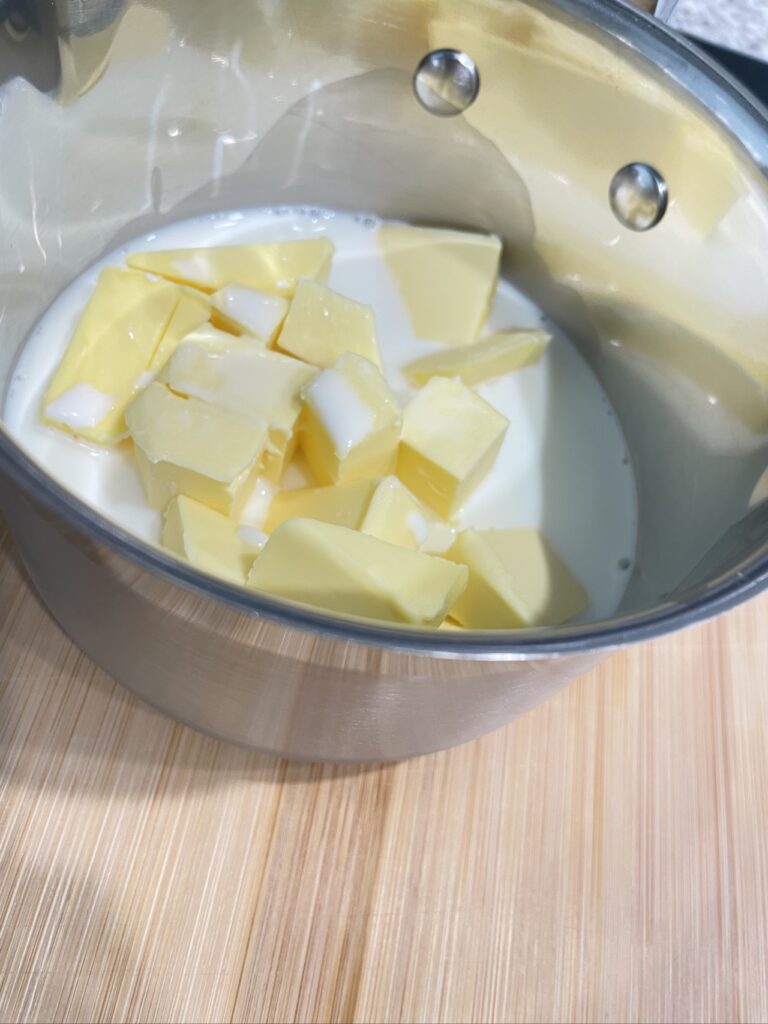
In a large mixing bowl, mix the flour and dry yeast. Add sugar, vanilla essence, salt and the egg. Hook your bowl into your stand mixer and attach the dough hook. Turn the stand mixer on low speed to mix the dough.
As the mixture comes together, start to slowly add the milk and butter mixture. If you have a splash guard, I would recommend adding it before pouring the liquid. Otherwise just take your time adding the liquid to avoid it splashing everywhere.
Knead the dough for around 5 minutes. It should be a smooth and glossy dough which easily falls off the hook when tilting the mixer’s head up. If your dough still looks clumpy or you’re simply unsure if it’s ready yet, mix it for another few minutes to really come together.
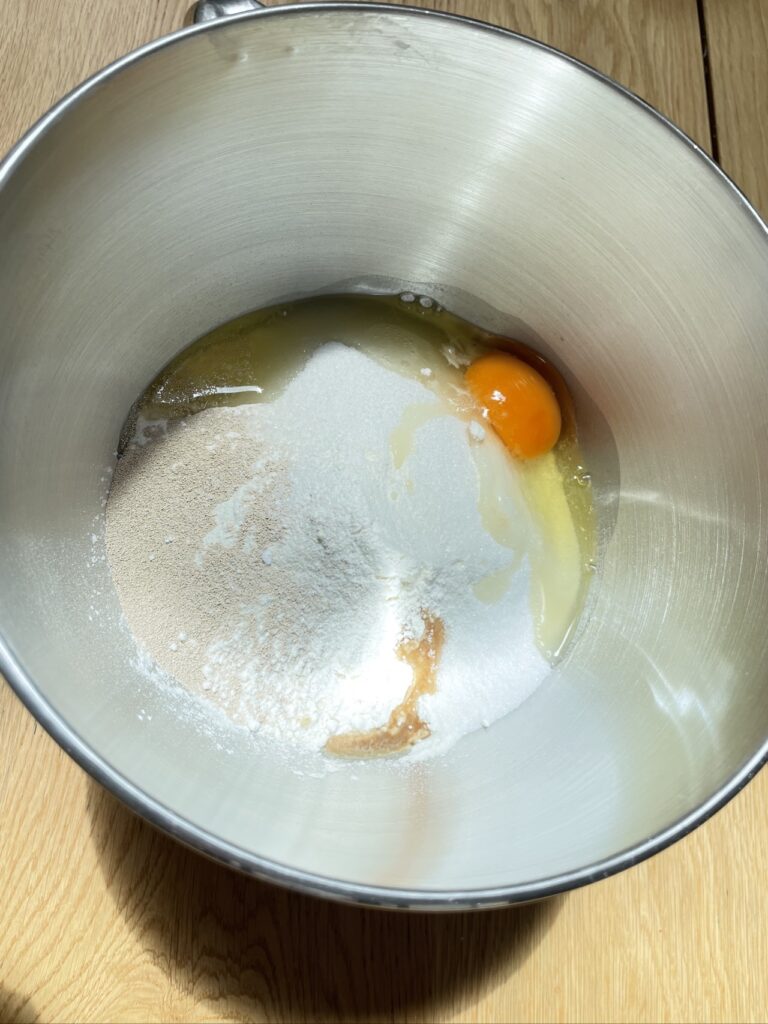
Now it’s time for your dough to rise. Remove the bowl from the stand mixer and place a lid, damp tea tower or cling film over it. Place the bowl somewhere warm – a spot in the sun, the shelf above the fridge or a table near the fire place are ideal. Make sure your dough doesn’t overheat as this will impact the yeast’s rising powers. Aim for ideally around 25- 30 degrees Celsius / 80 degrees Fahrenheit.
Ready for braiding
After about 1.5 hours your dough should have more or less doubled in volume. Move your dough onto a floured surface and divide it into three equal pieces. Prepare a baking tray by laying parchment paper onto it.
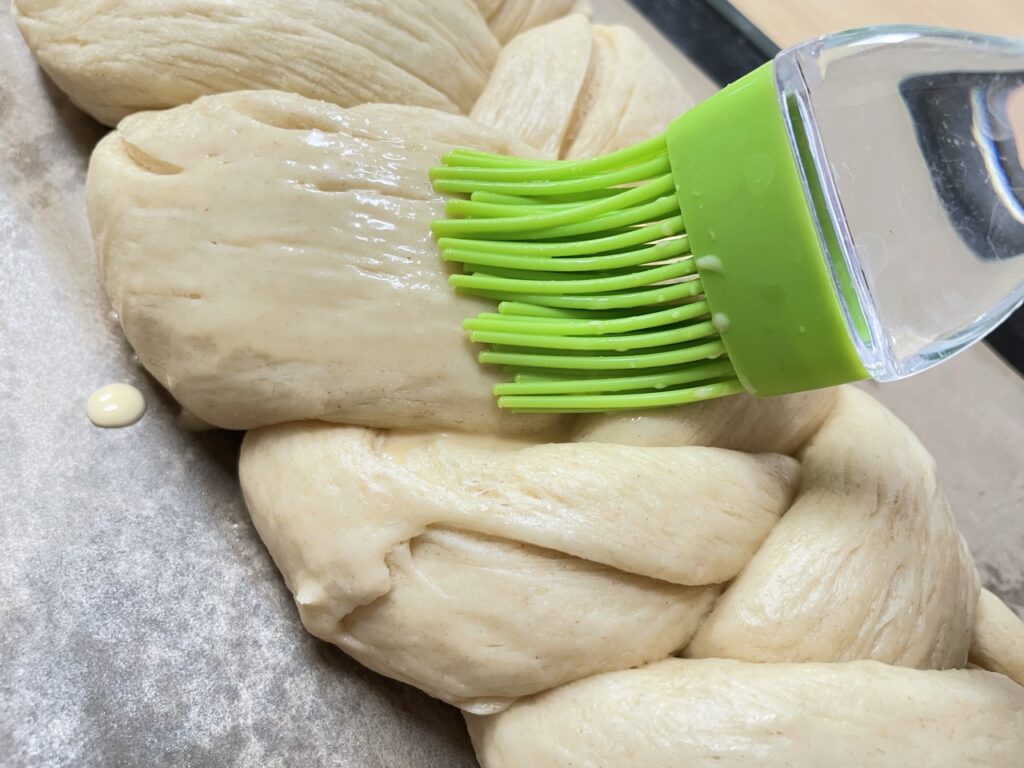
Roll the three pieces of dough into three evenly long strands. These should be at least 40cm long to allow sufficient length to braid your Hefezopf. Take your three strands and braid your zopf. Take the beginning and end pieces and tuck them under the zopf to make it look less messy.
Place the braided zopf onto the parchment paper. Cover the Hefezopf with cling film or a damp towel and allow it to rise in a warm spot for another 30-60 minutes.
While the Hefezopf is rising, pre-heat the oven to 200 degrees Celsius / 400 degrees Fahrenheit at upper and lower heat. Whisk an egg yolk and a little milk together and brush it all over your Hefezopf. Sprinkle sugar crystals all over it. Don’t be shy when adding the sugar crystals, they will make your Hefezopf look beautiful.
Bake the Hefezopf for around 30 minutes until golden. To test it is fully baked through, insert a wooden shashlik stick into the middle of the Hefezopf. If dough still sticks to it, bake it for a little longer until the stick comes back clean.

Tips and tricks
- Working with dry yeast, aim for your ingredients to be at room temperature before preparing the dough.
- Heating the milk up too hot will impact the yeast’s rising power. Aim to keep it at room temperature or cool it down after melting the butter in it if it got too hot on the stove.
- Moving the braided dough from the bench top to the baking sheet can be a little tricky. I often lay my parchment paper on the bench and braid my dough directly on it. An extra set of hands makes the transfer to the baking sheet super easy.
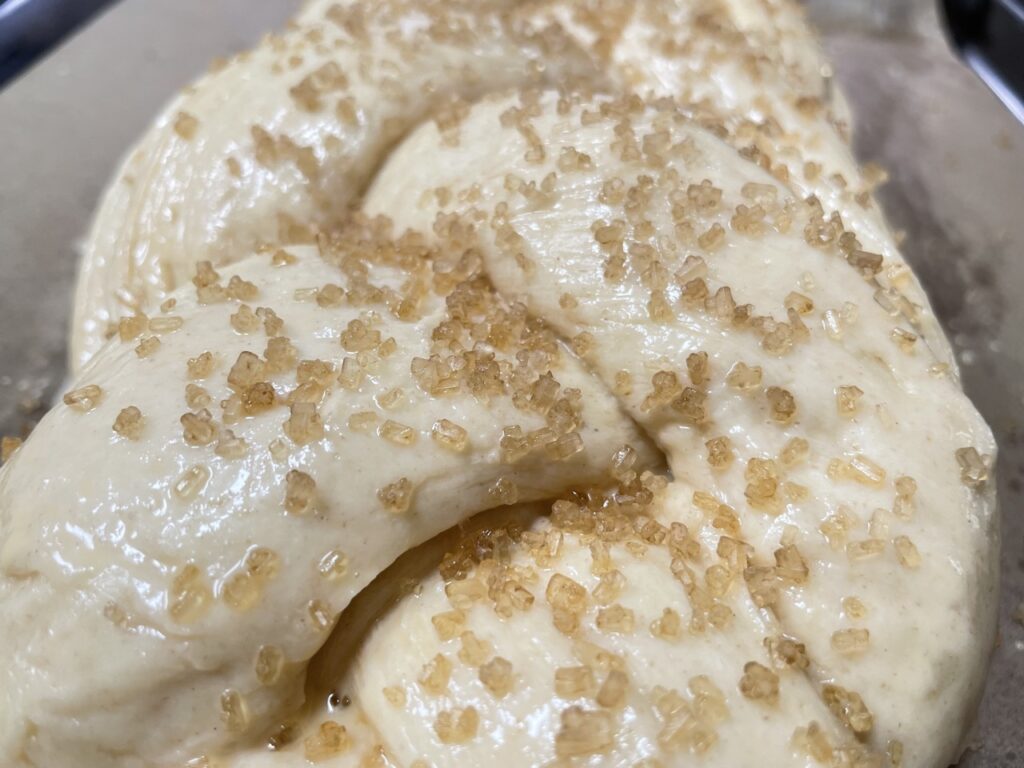
What is the difference between Challah and Hefezopf?
While Challah and Hefezopf are remarkably similar, Challah uses honey and oil while Hefezopf relies on sugar and butter. Hefezopf is usually sprinkled with sugar crystals, sometimes with silvered almonds. Challah on the other hand has a few more varieties and can be seen with toppings such as sesame or poppy seeds.
How many types of bread are there in Germany?
According to the German Bread Institute, there are 3,048 known and acknowledged types of bread in Germany. If you ever visit the country, make the time to visit a few of the smaller bakeries. You will be amazed at just how many different types, shapes and colours of bread you will see displayed on the shelves. Germany also has a great variety of regional breads, making meal time even more exciting as you travel around the country.

Why do Germans eat so much bread?
In my personal opinion, because it’s the best food in the world! Growing up with such a huge variety of bread, Germans serve bread at every opportunity possible. While it is an obvious choice for breakfast, we also love a mid-morning sandwich, or load it with cold cuts, cheeses and fresh vegetables at dinner time. I firmly believe that the huge variety and great quality of whole grains used have established bread as our very favourite staple.
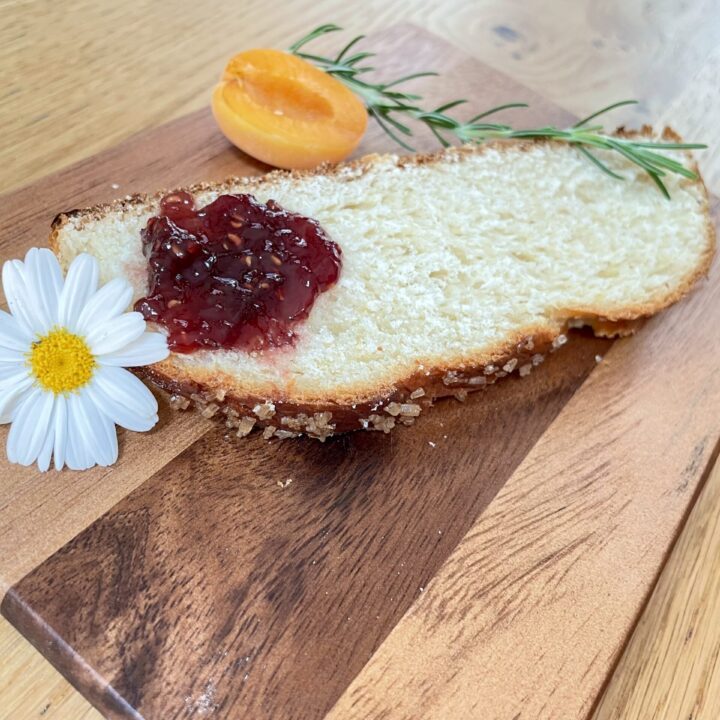
Hefezopf recipe for sweet German bread
THE dish in the South of Germany, Hefezopf will become a staple in your home, too.
Ingredients
- For the dough:
- 500g flour
- 100g butter
- 250ml milk
- 1 packet dry yeast
- 100g sugar
- 1 Tsp vanilla essence
- 1/2 Tsp salt
- 1 egg
- For the egg wash:
- 1 egg yolk
- 1 Tbsp milk
- Topping:
- 1/4 cup sugar crystals
Instructions
- First, let’s warm up the milk and melt our butter in it. Pour your milk into a small sauce pan and add your butter to it. Place the pot on low to medium heat to allow the butter to melt. Given we want to add this mixture to our dough, this should not turn hot. If the melted mixture is too warm to touch, place the pot into a bowl of cold water once to butter has melted to allow for the mixture to cool down a little.
- In a large mixing bowl, mix the flour and dry yeast. Add sugar, vanilla essence, salt and the egg. Hook your bowl into your stand mixer and attach the dough hook. Turn the stand mixer on low speed to mix the dough.
- As the mixture comes together, start to slowly add the milk and butter mixture. If you have a splash guard, I would recommend adding it before pouring the liquid. Otherwise just take your time adding the liquid to avoid it splashing everywhere.
- Knead the dough for around 5 minutes. It should be a smooth and glossy dough which easily falls off the hook when tilting the mixer’s head up. If your dough still looks clumpy or you’re simply unsure if it’s ready yet, mix it for another few minutes to really come together.
- Now it’s time for your dough to rise. Remove the bowl from the stand mixer and place a lid, damp tea tower or cling film over it. Place the bowl somewhere warm - a spot in the sun, the shelf above the fridge or a table near the fire place are ideal. Make sure your dough doesn’t overheat as this will impact the yeast’s rising powers. Aim for ideally around 25- 30 degrees Celsius / 80 degrees Fahrenheit.
- After about 1.5 hours your dough should have more or less doubled in volume. Move your dough onto a floured surface and divide it into three equal pieces. Prepare a baking tray by laying parchment paper onto it.
- Roll the three pieces of dough into three evenly long strands. These should be at least 40cm long to allow sufficient length to braid your Hefezopf. Take your three strands and braid your zopf. Take the beginning and end pieces and tuck them under the zopf to make it look less messy.
- Place the braided zopf onto the parchment paper. Cover the Hefezopf with cling film or a damp towel and allow it to rise in a warm spot for another 30-60 minutes.
- While the Hefezopf is rising, pre-heat the oven to 200 degrees Celsius / 400 degrees Fahrenheit at upper and lower heat. Whisk an egg yolk and a little milk together and brush it all over your Hefezopf. Sprinkle sugar crystals all over it. Don’t be shy when adding the sugar crystals, they will make your Hefezopf look beautiful.
- Bake the Hefezopf for around 30 minutes until golden. To test it is fully baked through, insert a wooden shashlik stick into the middle of the Hefezopf. If dough still sticks to it, bake it for a little longer until the stick comes back clea
